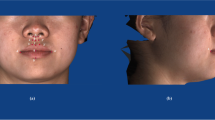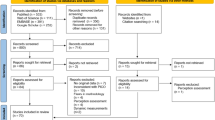Abstract
Background
Lip augmentation and changing contour lines have become more popular ways of improving the appearance. However, validated measures of lip fullness for quantification of outcomes are needed; ethnic background and personal goals can optimise outcomes while tailoring lip enhancement treatment to each individual’s anatomy. The aim of this study is to analyse the morphological features of the lip in detail and to clarify the objective parameters in related with the subjective ones regarding the lip augmentation and lip reconstruction.
Methods
Standard photographs of the lips of 200 young Anatolian adults were calculated with linear and angular components. The features of the lower third of the face were analysed with the software program. Linear analyses (heights of the upper lip, the upper vermilion, the lower lip height, the lower vermillion and the chin height) and angular analyses (the upper lip, the lower lip, the apex and Cupid’s bow angles) were measured as reference points. The lip shape was classified into five groups: thin, very thin, medium, full and very full.
Results
The lower third of the face was divided into three segments (Sn–Sto, Sm–Me and Sto–Sm), and the largest portion of the lower face was occupied by the chin and the smallest by the lower lip height in both genders. The upper vermilion height was 8.07 ± 1.8 mm in males and 7.08 ± 1.5 mm in females. The lower vermilion height was 10.1 ± 2.4 mm in males and 9.7 ± 1.9 mm in females. The upper lip angle was calculated as 30.3 ± 9.6° in males and 24.2 ± 6.2°mm in females. The lower lip angle was calculated as 38.3 ± 9.7° in males and 36.5 ± 6.4° in females. Meanwhile, the angular measurements of Cupid’s bow (i.e., the apex and the central angle of Cupid’s bow) were smaller in men than in women. When the lip was analyzed, the medium and full types in upper and lower lips accounted for substantial fractions in men, whereas medium and thin types were predominant also in women.
Conclusions
With the help of certain software, this research has made possible to define the best cosmetical redesign solution of lip construction and augmentation with a natural appearance for the patient.
Level of Evidence: Level III, diagnostic study.







Similar content being viewed by others
References
Jacono A (2008) A new classification of lip zones to customize injectable lip augmentation. Arch Facial Plast Surg 10(1). doi:10.1001/archfaci.10.1.25.
Carey J, Cohen M, Curry C, Devriendt K, Holmes L, Verloes A (2009) Elements of morphology: standard terminology for the lips, mouth, and oral region. Am J Med Genet 149A(1):77–92
Raphael P, Harris R, Harris S (2013) Analysis and classification of the upper lip aesthetic unit. Plast Reconstr Surg 132(3):543–551
Alam M, Gladstone H, Kramer E et al (2008) ASDS Guidelines of Care: injectable fillers. Dermatol Surg 34(s1):S115–S148
Burstone C (1967) Lip posture and its significance in treatment planning. Am J Orthod 53(4):262–284
Clymer M (2007) Evolution in techniques: lip augmentation. Facial Plast Surg 23(1):021–026
Kane M, Lorenc Z, Lin X, Smith S (2012) Validation of a lip fullness scale for assessment of lip augmentation. Plast Reconstr Surg 129(5):822e-828e. doi:10.1097/prs.0b013e31824a2df0.
Lemperle G, Anderson R, Knapp T (2010) An Index for quantitative assessment of lip augmentation. Aesthet Surg J 30(3):301–310
Anic-Milosevic S, Mestrovic S, Prlić A, Slaj M (2010) Proportions in the upper lip–lower lip–chin area of the lower face as determined by photogrammetric method. J Craniomaxillofac Surg 38(2):90–95
Gunduz Arslan S, Genç C, Odabaş B, Devecioğlu KJ (2007) Comparison of facial proportions and anthropometric norms among Turkish young adults with different face types. Aesthetic Plast Surg 32(2):234–242
Farkas L, Katic M, Forrest C (2005) International anthropometric study of facial morphology in various ethnic groups/races. J Craniofac Surg 16(4):615–646
Rhee S, Dhong E, Yoon E (2008) Photogrammetric facial analysis of attractive Korean entertainers. Aesthetic Plast Surg 33(2):167–174
Wong W, Davis D, Camp M, Gupta S (2010) Contribution of lip proportions to facial aesthetics in different ethnicities: a three-dimensional analysis. J Plast Reconstr Aesthet Surg 63(12):2032–2039
Garcia de Mitchell C, Pessa J, Schaverien M, Rohrich R (2008) The Philtrum: anatomical observations from a new perspective. Plast Reconstr Surg 122(6):1756–1760
Jones L, Tatum S (2008) Pearls for aesthetic reconstruction of cleft lip and nose defects. Facial Plast Surg 24(1):146–151
Nakamura N, Suzuki A, Takahashi H, Honda Y, Sasaguri M, Ohishi M (2005) A longitudinal study on influence of primary facial deformities on maxillofacial growth in patients with cleft lip and palate. Cleft Palate Craniofac J 42(6):633–640
Schwenzer-Zimmerer K, Chaitidis D, Boerner I, et al (2008) Systematic contact-free 3D topometry of the soft tissue profile in cleft lips. Cleft Palate Craniofac J 45(6):607–613
Schwenzer-Zimmerer K, Chaitidis D, Berg-Boerner I, et al (2008) Quantitative 3D soft tissue analysis of symmetry prior to and after unilateral cleft lip repair compared with non-cleft persons (performed in Cambodia). J Craniomaxillofac Surg 36(8):431–438
Wu D, Wang Y, Song T, et al (2014) Aesthetic reconstruction of the upper lip with novel split musculomucosal-pedicle cross-lip flap. Ann Plast Surg 73:S88–S91
Pepper J, Baker S (2013) Local flaps: cheek and lip reconstruction. JAMA Facial Plast Surg 15(5):374
Starmer H, Lyford-Pike S, Ishii L, Byrne P, Boahene K (2015) Quantifying labial strength and function in facial paralysis. JAMA Facial Plast Surg 17(4):274
Kale-Varlk S (2008) Angular photogrammetric analysis of the soft tissue facial profile of Anatolian Turkish adults. J Craniofac Surg 19(6):1481–6
Mulliken J, Pensler J, Kozakewich H (1993) The anatomy of Cupidʼs bow in normal and cleft lip. Plast Reconstr Surg 92(3):404
Smith S, Lin X, Shamban A (2013) Small gel particle hyaluronic acid injection technique for lip augmentation. J Drugs Dermatol 12(7):764–9
Wollina U. Perioral rejuvenation: restoration of attractiveness in aging females by minimally invasive procedures (2013). Clin Interv Aging 8:1149–1155.
Bo C, Ningbei Y (2014) Reconstruction of upper lip muscle system by anatomy, magnetic resonance imaging, and serial histological sections. J Craniofac Surg 25(1):48:54
Kishi N, Tanaka S, Iida S, Kogo M (2012) The morphological features and developmental changes of the philtral dimple: a guide to surgical intervention in cases of cleft lip. J Craniomaxillofac Surg 40(3):215–222
Bishara S, Jorgensen G, Jakobsen J (1995) Changes in facial dimensions assessed from lateral and frontal photographs. Part I-Methodology. Am J Orthod Dentofacial Orthop 108(4):389–393
Bishara S, Jorgensen G, Jakobsen J (1995) Changes in facial dimensions assessed from lateral and frontal photographs. Part II—results and conclusions. Am J Orthod Dentofacial Orthop 108(5):489–499
Onizuka T, Ichinose M, Hosaka Y, Usui Y, Jinnai T (1991) The contour lines of the upper lip and a revised method of cleft lip repair. Ann Plast Surg 27(3):238–252
Sepehr A, Mathew P, Pepper J, Karimi K, Devcic Z, Karam A (2012) The Persian woman’s face: a photogrammetric analysis. Aesthetic Plast Surg 36(3):687–691
Anic-Milosevic S, Lapter Varga M, Slaj M (2008) Analysis of the soft tissue facial profile of Croatians using of linear measurements. J Craniofac Surg 19:251–258
Anic-Milosevic S, Lapter-Varga M, Slaj M (2008) Analysis of the soft tissue facial profile by means of angular measurements. Eur J Orthod 30(2):135–140
Rogers C, Meara J, Mulliken J (2014) The philtrum in cleft lip. J Craniofac Surg 25(1):9–13
Yamada T, Mori Y, Minami K, Mishima K, Sugahara T (2002) Three-dimensional facial morphology, following primary cleft lip repair using the triangular flap with or without rotation advancement. J Craniomaxillofac Surg 30(6):337–342
Choi H, Kim S, Han Y (2013) A new method for creating a definite philtrum by the flipping of an orbicularis oris muscle flap in a patient with an indistinct philtrum. Arch Plast Surg 40(1):62
Malkoc S, Demir A, Uysal T, Canbuldu N (2009) Angular photogrammetric analysis of the soft tissue facial profile of Turkish adults. Eur J Orthod 31(2):174–179
Ozdemir S, Sigirli D, Ercan I, Cankur N (2008) Photographic facial soft tissue analysis of healthy Turkish young adults: anthropometric measurements. Aesthetic Plast Surg 33(2):175–184
Germec-Cakan D, Canter H, Nur B, Arun T (2010) Comparison of facial soft tissue measurements on three-dimensional images and models obtained with different methods. J Craniofac Surg 21(5):1393–1399
Hood C, Hosey M, Bock M, White J, Ray A, Ayoub A (2004) Facial characterization of infants with cleft lip and palate using a three-dimensional capture technique. Cleft Palate Craniofac J 41(1):27–35
Author information
Authors and Affiliations
Corresponding author
Ethics declarations
Ethical standards
This study has been approved by the Institutional Review Board and has therefore been performed in accordance with the ethical standards laid down in the 1964 Declaration of Helsinki and its later amendments. This manuscript does not contain clinical studies. Anonymized data with a number were used to develop a practical approach.
Funding
None.
Conflict of interest
Hassan Bagheri, Suzan Sirinturk, Figen Govsa, Yelda Pinar and Mehmet Asim Ozer declare that they have no conflict of interest.
Patient consent
This study was carried out in accordance with the protocols of our institution concerning the publication of patient data. All the participants were properly informed and gave their written informed consent before their inclusion in the study. Additional consent was obtained for the use of their photographs.
Rights and permissions
About this article
Cite this article
Bagheri, H., Sirinturk, S., Govsa, F. et al. Computer-assisted analysis contour lines of aesthetic unit for the assessment of lip augmentation. Eur J Plast Surg 39, 265–272 (2016). https://doi.org/10.1007/s00238-016-1190-x
Received:
Accepted:
Published:
Issue Date:
DOI: https://doi.org/10.1007/s00238-016-1190-x




